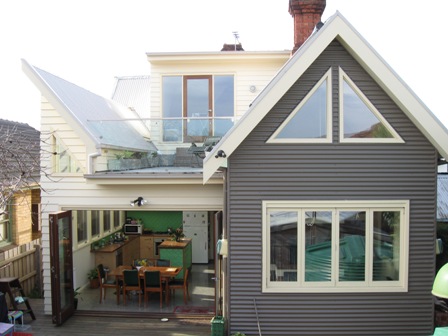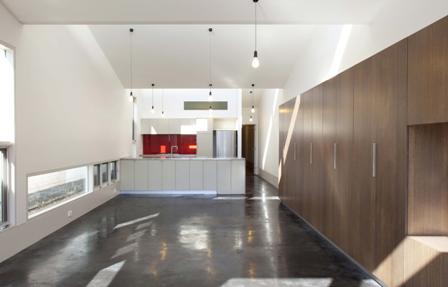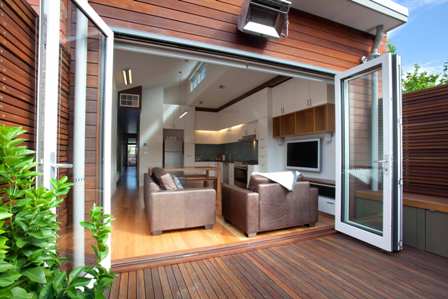The Legs House 4 by Ed Ewers Architecture
The brief for the existing 1930s weatherboard home was to incorporate new ESD initiatives (wall and ceiling insulation, improved floor structure, draft proofing, double glazed, rewiring and heating). The project has a 6 star energy rating.
Initiatives:
• increased wall insulation R3.5 and roof insulation R7.0
• concrete slab floor and double glazing
• 13,500 litre rain tanks liked to two WCs, washing machine, pool and garden (which is a native drought tolerant garden)
• solar hot water system and gas hydraulic heating
• Marmoleum flooring over two layers of sheet flooring
• all hardwood from the demolition was salvaged and stored for firewood
• old Baltic pine floorboards salvaged and re-used as internal lining on another project
• all scrap metal recycled, as were old joinery limits, fittings and fixtures
• during demolition all recyclable products were separated and disposed and/or re-used appropriately
 Plow House Sustainable Renovation by Positive Footprints
Plow House Sustainable Renovation by Positive Footprints
The site for the renovation was a tight inner suburban block with poor solar access due to the neighbouring house being just off the northern boundary. The existing 100 year-old 1 star home had recently been renovated in the front rooms (to remain untouched), posing challenges as thermal modelling showed a large winter energy deficit in this part of the building.
Initiatives:
• the design allows the sunlight to fall directly onto the mass of the internal brick wall and the polished concrete floor, which then store the sun's heat
• large opening bifolds and casement windows maximise available summer breezes for passive cooling and night purging of the internal mass
• the tank is sized to give around one month’s water security between rain events. Through water efficiency, rainwater collection and greywater re-use the house should only use one-third of the mains water use of a standard Melbourne house
• a 1.5 kW panel grid connected photovoltaic power generation system provides power to the house, with excesses supplied back to the grid
• the newly added living areas are performing at an 8 star level, whilst the sealing of gaps and cracks and blocking of chimneys has improved the existing front section. As a whole the house is now rating 5 stars
 Newry Street by Breathe Architecture
Newry Street by Breathe Architecture
By appropriating the form of a neighbouring sawtooth factory building to break up the roof plane and opening out the new spaces onto a northern courtyard, the regeneration of the existing 1900s Victorian terrace house provides a spacious living, dining and kitchen area for a professional couple.
Initiatives:
• awnings to the northern windows and eaves to the highlight windows allow winter sun to enter the building while excluding harsh summer sun
• new casement windows to the east take advantage of prevailing breezes for natural cross ventilation
• hydronic heating system has been installed within the slab which, when preheated by the winter sun, circulates its heat throughout the house
• low embodied energy materials
• all new windows double glazed
• two 4,000 litre slimline rainwater tanks installed and plumbed into toilet cisterns, laundry and garden taps to reduce mains water usage by around 70,000 litres per year
• materials and fixtures salvaged during demolition were sold for reuse
 Fraser Street by Breathe Architecture
Fraser Street by Breathe Architecture
The primary objective behind the design was to achieve a sustainable, inner city house for a small family within a minimal footprint. Through the spatial reordering of a single-storey Victorian terrace and new eastern extension, the design allows the building to function efficiently as a family home.
Initiatives:
• opening the eastern side of the building to provide more living space enabled the kitchen and living areas to be reoriented to the courtyard
• brick party wall acts as a thermal mass element, capturing the sun’s heat and radiating it back into the living areas throughout winter
• water tanks and solar hot water were not required, however both were installed and as a result well exceeded mandatory standards
• new operable highlight windows to the north and sliding door to the east funnels breezes through the building for natural cross ventilation
• all new windows double glazed, while all new external walls have a dual layering of insulation batts and foilboard to maximise thermal performance
+%7c+Architecture+%26+Design&pu=/awards-1/past-awards/bpn-sustainability-awards-finalists-single-d-1&pt=_Article)
+%7c+Architecture+%26+Design&pu=/awards-1/past-awards/bpn-sustainability-awards-finalists-single-d-1&pt=_Article)